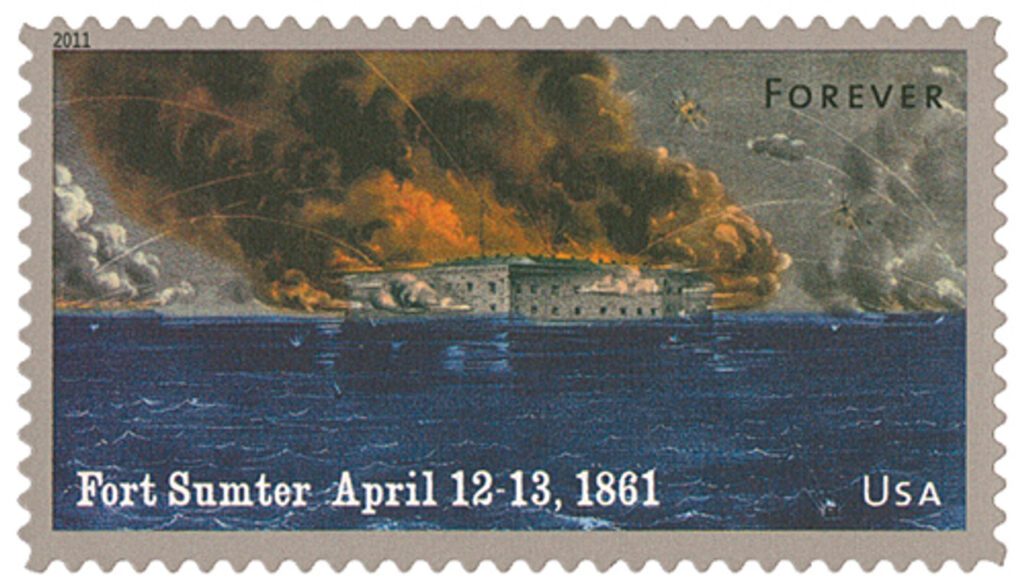
On January 9, 1861, Southern rebels fired on an American ship attempting to resupply Fort Sumter. Some consider these to be the opening shots of the Civil War.
The day after Christmas in 1860, rowboats sliced quietly across Charleston Harbor under cover of darkness. South Carolina had seceded six days earlier, leaving Union Major General Robert Anderson and his group of 127 men stranded at Fort Moultrie, deep within rebel territory. Anderson and his troops left Fort Moultrie, which was impossible to defend, for the daring journey to nearby Fort Sumter, which was stronger. Construction was not complete and the cannons were not all in place. But as the sun rose, Anderson’s men proudly hoisted the Stars and Stripes over Fort Sumter, where it floated above the entrance to South Carolina’s most important port city.
South Carolina Governor Francis W. Pickens was outraged. President Buchanan had promised him the federal government would not reinforce any of the forts in South Carolina, which the southerners considered this action to be. The locals demanded that the federal troops leave the garrison at Fort Sumter. Though President James Buchanan refused to evacuate the fort, he also decided not to take any further action that might incite a riot among the southerners.
However, the fort’s commander, Major Robert Anderson, and his 80 soldiers were running low on supplies. President Buchanan decided to send a civilian ship, the Star of the West, instead of a military vessel. This ship was loaded with food, small arms, and about 200 men.
The Star of the West departed New York on January 5, 1861. Shortly after, Secretary of War Joseph Holt received word that the supplies were not needed immediately and that secessionists had set up guns overlooking Charleston Harbor. Holt realized the ship was now in danger and attempted to have it brought back, but was unable to communicate with it.
Fearing this was the assault they’d expected since secession, Southerners rushed to Charleston by the thousands to man shore batteries and fire at the ship. Among those assembled were young men from the Citadel, South Carolina’s military academy. On January 9, the ship entered the channel, not knowing the danger that awaited. George E. Haynsworth, a Citadel cadet stationed at the Morris Island battery, fired two shots at it. More shots followed, with only one causing minor damage.

At Fort Sumter, Anderson watched the action but chose not to intervene, as that may have sparked an all-out battle. Eventually, the ship’s captain abandoned the mission and returned to New York. Months later, the Star of the West was captured by Confederates who later sunk it. The ship’s owners received $175,000 from the US government for their loss after the war ended.
South Carolina seized all federal property in Charleston except Fort Sumter, including Fort Moultrie. General Pierre G.T. Beauregard was sent to fortify the area around Charleston Harbor for battle. Beauregard surrounded Fort Sumter with a force of about 6,000 troops and 19 batteries. He ordered its surrender on April 11, 1861, but Anderson refused.

In the early morning of April 12, the Confederate batteries opened fire on the fort and continued the bombardment for 34 hours. The ammunition inside Fort Sumter was in short supply from the start, so the defense of the fort was ineffective. Major Anderson surrendered the fort in the afternoon of April 13. The first battle of the Civil War ended in Confederate victory, but the war had just begun.
| FREE printable This Day in History album pages Download a PDF of today’s article. Get a binder or other supplies to create your This Day in History album. |
Discover what else happened on This Day in History.



Yep, the Civil War might have started then and there, but President James Buchanan allowed the incident to pass without a response. He preferred to let his successor Abraham Lincoln to decide what to do about resupplying Fort Sumter.